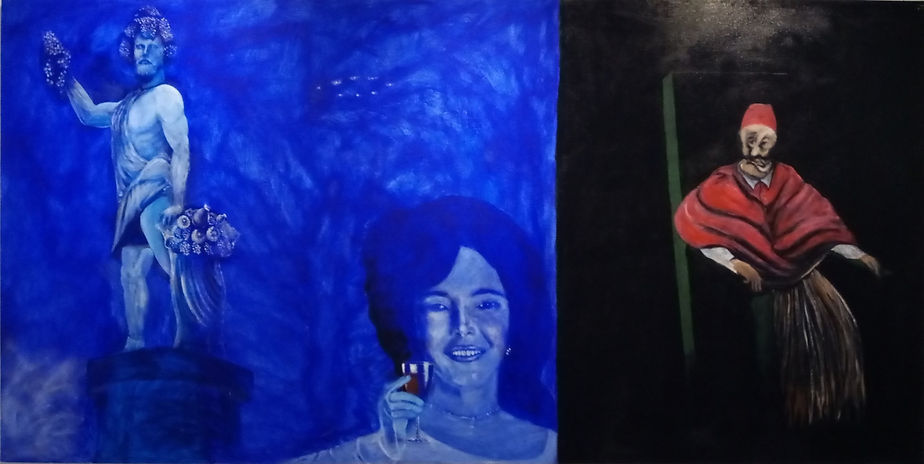
Bacchus and Ariadne (After Titian), 2019, acrylic on canvas, 96" x 48"
THIS 4 x 8-foot painting, titled Bacchus and Ariadne (After Titian), alludes to the famous Titian painting, but with an imitation of a Francis Bacon study of Pope Innocent X embedded into the composition on the painting’s left side (the viewer’s right). This juxtaposition made the piece more than a simple variation on the Titian.
What could be the significance of the Pope’s presence in the painting’s left panel? Well, it must be recalled that Titian’s Bacchus and Ariadne piece was painted during a time when the Catholic Church hierarchy wanted the ultramarine color used exclusively for paintings of the Virgin Mary. Made with powdered lapis lazuli during this time, ultramarine was then a pretty expensive imported pigment, shipped from Afghanistan, that took months to reach Venice.
Titian, who was actually one of the Church’s favorite painters, was then commissioned by a duke to do a mural with classical mythological themes. And when Titian painted his Bacchus and Ariadne scene for the commission, he rebelled from the Church dictum―perhaps with tongue in cheek―and placed ultramarine color not only on the sky with the Northern Crown, which was probably still acceptable, but also on the skirts of Ariadne and a female reveler’s. And that is why a Pope is there on the left of de Veyra’s painting, looking displeased at all the wanton use of the ultramarine to his right. (Of course, however, today almost all ultramarine pigment sold in art supply stores is synthetic, but that doesn’t take away the value of the history around the ultramarine as it pertains to the Church.)
The painter Marcel Antonio, de Veyra’s friend, told de Veyra that he read somewhere that it wasn’t always like this. That before lapis lazuli came into the picture, the female painting figures were given the red color, and the males were given the blue. It was when lapis lazuli came along that things got reversed, with the Virgin Mary getting the most expensive blue: lapis lazuli. . . .
There is further significance to the Pope’s presence in de Veyra’s painting. Bacchus is the god of wine. The Vatican, meanwhile, has tracts of land that have been used as vineyards. In that case, the Pope himself can here be read as one of the economic earthly gods of the planet’s wine supply.
Additionally, de Veyra had this personal reading of Ariadne’s story. During an interview, de Veyra stated that he speculated that maybe Ariadne wasn’t actually taken by Bacchus in the literal sense but, instead, only became a kind of “slave” to the god of wine (read: became an alcoholic right after Theseus left her). Francis Bacon, the painter of the Pope image that de Veyra copied to his painting’s left panel . . . also became a borderline alcoholic as well as a bit of a reveler in bacchanalia himself.
Note, again, that the Pope featured in the composition is Pope Innocent X, who was actually Bacon’s obsession. . . . Now, there is a version of the mythology that says Bacchus asked Theseus to leave Ariadne so that he, Bacchus, could have Ariadne for himself. Bacchus being a Donald Trump of sorts and Theseus being the rest of the 2016-2025 US Republican Party, Theseus obeyed. And thus, Ariadne became Bacchus’ girl, whom he gifted with the entire sky, crowning her with the Northern Crown. . . . Pope Innocent X sort of has a similar story, as per rumors during his time, wherein, after the Pope’s brother died, the latter’s wife supposedly moved into the Pope’s chambers and from that moment had a tremendous influence on Papal policies.
So, what de Veyra intended to be a simple (or not so complex) variation on Titian’s painting became both a multilayered history or narrative painting and a historical one.